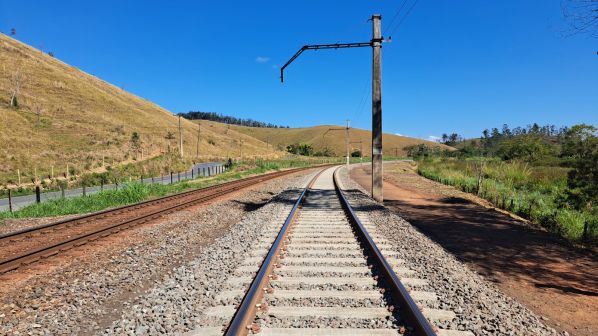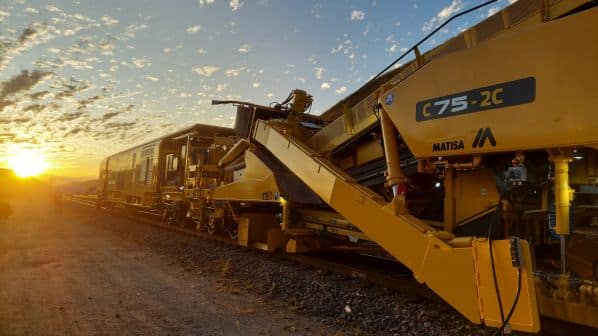DEEP in the Brazilian countryside, down winding roads, a major project is underway to modernise part of the country’s heavy-haul rail network that connects iron ore mines in the state of Minas Gerais with ports in the state of Rio de Janeiro.
The project is one of the major investments underway following the long-term renewal of the concession held by Brazilian freight railway MRS Logistics in July 2022, which has prompted a major programme to improve the 1643km network operated by the company across the states of Minas Gerais, Rio de Janeiro and São Paulo.
MRS Logistics was created in 1996, when the government privatised the southeast regional rail network. The southeast region which the network serves is responsible for generating about half of Brazil’s GDP, and MRS says that approximately 20% of the freight volume exported in Brazil and one third of all freight transported by rail in the country passes over its network.
The railway operates a fleet of more than 18,000 wagons and 800 locomotives.
The company’s initial concession was due to expire in 2026, but the contract signed with the federal government in the 1990s provided for an early renewal, which MRS applied for in 2015 before presenting its business plan and holding public hearings to gather input.
On July 27 2022, the board of the National Land Transport Agency (ANTT) approved the studies and documents for the early renewal of the contract to operate the network, with the agreement extending the contract until 2056 signed on July 29 2022. Under the terms of the new contract, MRS plans to double the volume of general freight and multiply the volume of intermodal freight by seven times over the new contract period.
The new contract includes an investment plan drawn up in conjunction with the Ministry of Infrastructure and ANTT, which is based on three pillars: expanding capacity to meet performance targets; structuring investment in the public interest; and work to improve urban mobility and minimise conflict with road traffic in urban areas. Overall, MRS plans to invest Reais 31bn ($US 6.3bn) by 2056, including an outlay of around Reais 11bn in infrastructure work and purchasing promised in return for the early renewal of the concession.
MRS is now working towards meeting the more than 500 obligations included in the plan, which are designed to guarantee the quality of the services provided by the company, to maintain the assets in perfect operating condition and to improve the level of service for customers.
Track renewal
Among the company’s current investments is a $US 500m project to renew more than 560km of 1600mm-gauge track on the Steel Railway and Serra do Mar lines, which carry iron ore from mines in Minas Gerais south to four ports in the state of Rio de Janeiro. Full wagons are moved along on the Steel Railway from Itabirito, Minas Gerais, to Barra Mansa, Rio de Janeiro, before travelling on the double-track line from Serra do Mar to the four ports of Rio de Janeiro, Itaguai, Sudeste, and Guaiba. Empty wagons are then transported back to Minas Gerais on the Central Line of which MRS operates the southern broad-gauge section.
Track renewal is due to take place between 2022 and 2033 at a rate of more than 50km a year. Ballast on the lines has reached the end of its useful life, with low resistance and high variation in stiffness causing significant dynamic impacts. The project includes undercutting and renewing the ballast along the route, which began in September 2022, as well as replacing the wooden and steel sleepers with concrete sleepers, which began in April 2023.
The launch of the project followed a decade of planning, including research into which track machines would be best suited to the challenging requirements of the Brazilian network. After conducting its market research, MRS purchased:
- two 09-2X tamping machines, two USP 2005 ballast profiling machines, a Unimat 08/475 S 3S tamping machine, and a PBR 500 ballast profiling machine from Plasser & Theurer
- an LRV Railvac rail-mounted excavating machine and 17 MHC series material-handling wagons from Loram, and
- a C 75-2C double-screen ballast cleaner and a P 190 track renewal train, with two material handling wagons, from Matisa.
“We selected the machines according to the maintenance needs identified for our line, the line clearance and the maintenance interval model proposed for our situation,” says MRS railway maintenance specialist, Mr Fábio Melo. “Due to the need for complete ballast cleaning of the tracks and the replacement of sleepers, taking into account the line clearance and the commercial and technical proposals, we decided on a total undercutting machine, a Matisa renewal train and the Loram vacuum ballast cleaner.”
The Matisa C 75-2C ballast cleaner has capacity to excavate 900m3 of ballast an hour and screen 1500m³ per hour, with two free oscillating screens, and can operate on curves of down to 150m radius. The machine has 12 powered axles, and multiple interchangeable excavating units to adapt to various worksite conditions.
A Catt guiding system minimises the amount of corrections to track geometry after ballast cleaning. The P 190 track renewal train is able to lay up to 650m of sleepers per hour.
“We selected the machines according to the maintenance needs identified for our line, the line clearance and the maintenance interval model proposed for our situation.”
Mr Fábio Melo, MRS railway maintenance specialist
Training of maintenance and operating personnel was provided by the equipment manufacturers, Melo says, with specialised technical support staff hired to continue staff development. Specialist experts who have already worked with similar models of machines were also hired.
Work is now well underway, with around 15km of track already renewed in the Pinheiral region by the end of November. In August, MRS organised a visit to the section between Valdemar de Brito and Vargem Alegre during the International Heavy Haul Association (IHHA) conference in Rio, which enabled attendees to see the project at first hand and to discuss with the engineers the lessons learned so far, as well as to provide advice on ways to further improve the project and the operation of the machines.
The visit
During the visit, IHHA delegates saw how the first line had been completed, with work underway on the second. Trains were continuing to operate on the completed line while work was still underway. Both the ballast cleaning and track renewal trains were in operation, about 2km apart, with both followed by a tamping machine.
Working on track that hasn’t been renewed for more than 100 years is not easy, Melo says.
“Because we’ve gone a long time without cleaning the ballast, we encountered several obstacles on the railway line such as pieces of buried track, which affects the reliability of the equipment,” he says.

It was also challenging to gather a team that was suitably qualified and experienced to plan, schedule and execute such a major project. The high number of tunnels and viaducts has caused issues with clearances, along with the geometric alignment, with the tight curve radius in some locations directly interfering with planning.
The hot climate of Brazil has required the machines to be adapted due to the viscosity of oil used in Europe, while radiators needed to be adapted to avoid overheating.
The remoteness of the worksites has also required some Brazilian ingenuity, with MRS working with engineering firm ANX of Paulínia, São Paulo, to develop a maintenance wagon and staff wagon, which can be attached to the rear of the tamping or ballast cleaning train. Both are built using 20ft containers mounted on a flat wagon, modified to include a workshop inside the maintenance wagon, along with a small kitchen, toilet and staff room complete with TV inside the staff wagon. Both are air-conditioned, with MRS purchasing three of each.
“These wagons are necessary due to MRS’ work model, as we often work with night maintenance shifts,” Melo says. “As a result, we need field maintenance support from the maintenance wagon, and a dining area and space for administrative meetings in the staff wagon.”
The project also includes the construction of a new workshop to support the maintenance of the more than 26 machines and 81 wagons purchased for the track renewal project, a condition included in the concession renewal.
When complete the lines will be upgraded from maintenance class 3 to class 4, with axleloads increasing from 32.5 tonnes to 37.5 tonnes and the maximum speed raised to 64km/h.
This investment means that, despite the costs and challenges, MRS is well on its way to improving capacity and therefore its ability to meet its ambitious growth targets. It also means it will be leaving the infrastructure it took over in 1996 in a better condition than when it received it, and ready for expected traffic growth over the next 30 years or so.

